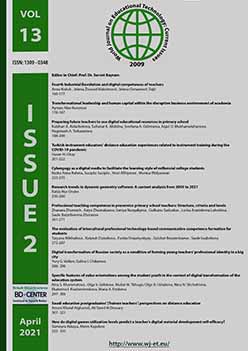How do digital games utilization levels predict a teacher’s digital material development self-efficacy?
How do digital games utilization levels predict a teacher’s digital material development self-efficacy?
Author(s): Sümeyra Akkaya, Metin KapıdereSubject(s): Education, Distance learning / e-learning
Published by: Birlesik Dunya Yenilik Arastirma ve Yayincilik Merkezi
Keywords: Digital games; digital material; material development; COVID-19 pandemic; self-efficacy;
Summary/Abstract: This study is a correlation research that aims to reveal whether digital material game usage sub-dimensions, gender, school level, in-service training for education in the digital environment, digital game playing status, devices and remote education variables, are significant predictors of digital material development self-efficacy level sub-dimensions. The study group consisted of 330 teachers. The study group consists of voluntary teachers from all education levels who provide remote education during the pandemic in Malatya city in the 2020–2021 academic year. This study found that there is a negative relationship between teachers’ seniority and Web 2.0 development self-efficacy; a positive significant relationship between attitudes to use digital games in the class and Web 2.0 development skills; higher design self-efficacy perception in teachers with in-service training compared to those who did not have in-service training; higher design self-efficacy for teachers with high attitude towards using digital games in class; and negative attitudes towards digital games increased as the negative perspective towards digital material development self-efficacy increased. Experimental and qualitative studies regarding digital game-based digital teaching material efficiency can be recommended
Journal: World Journal on Educational Technology: Current Issues
- Issue Year: 13/2021
- Issue No: 2
- Page Range: 322-335
- Page Count: 14
- Language: English

